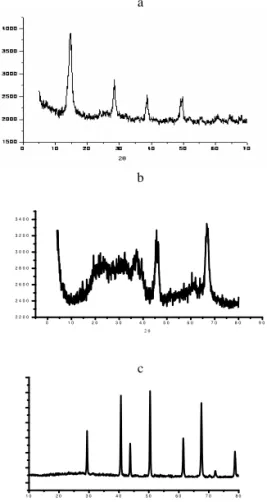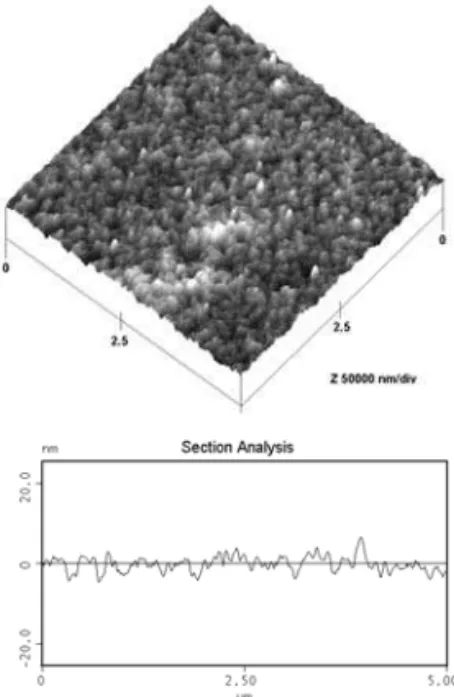236 Ronald A. Silva et al.
Preparation of Thin Films Using Freeze Drier Alumina
Ronald A. Silva, Cristina F. Diniz, Marcelo M. Viana, Suzeley L. Abreu1,2, Taiane G.F. de Souza1,2, Nelcy D. S. Mohallem∗ Laborat´orio de Materiais Nanoestruturados, Departamento de Qu´ımica, UFMG, 31270-901 Belo Horizonte-MG, Brazil
Tarik D. S. Mohallem
Nanum Nanotecnologia, Belo Horizonte, MG, Brazil
(Received 01/07/2008)
Synthesis of polymorphous of nanoparticulate alumina has been the subject of many works. The stabilization of these nanoparticles in aqueous suspensions is necessary in many technologic application and industrial prod-ucts. Recently, a number of routes have been developed using various dispersants to prepare these nanoparticles dispersed in aqueous solution. In this work, nanoparticulate alumina prepared by precipitation and freezing drying was investigated as potential material for aqueous dispersion. These nanoparticles were dispersed in methylethylglycol (MEG), polyvinylalcohol (PVA) and polymethacrylate (PMA). The alumina nanoparticles and the dispersions were characterized physical-chemically and tested in the preparation of thin films.
Keywords: alumina dispersion, alumina thin films, nanoparticulate alumina
I. INTRODUCTION
In recent studies, different kinds of nanoparticles in form of nanosphere, nanotube, nanowire, nanorod, nanoribbon, nanoplate, among others have been developed to application in diverse technologies [1]. These nanostructures have been obtained with different shapes and sizes, high specific sur-face area, and consequently with high reactivity. The knowl-edge obtained with these studies has brought important con-tributions to the advance of the nanotechnology. Therefore, nanoparticle productions present many difficulties depend-ing on the particular properties desired. The manipulation of these materials is very difficult, taking in account problems with fabrication, transport, final application and toxicity [2].
One way to manipulate this type of nanomaterial after syn-thesis consists in the preparation of colloidal dispersions. In that way the manipulation become easy and it is possible to prepare thin films from dispersions of low concentration, nanoabrasives from alpha-alumina disperse in high concen-trations and adequate dispersions to mix in precursor pastes of refractory materials. Colloidal dispersion is systems in which particles with dimension between 1 and 1000 nm are dispersed in a continuous phase. This kind of system can be formed due to four interaction energies: van der Waals, elec-trostatic, steric and depletion interaction energies. The col-loidal suspension must have appropriated physical-chemical properties to produce the final product with desired charac-teristics, such as transparent, adherent and homogeneous thin films, nanoabrasives or refractory material pastes.
The dispersion of alumina nanoparticles is more difficult than of the particles with size in the order of microns due to the tendency to agglomeration provoked by the high reactiv-ity.
In this study, we produced colloidal dispersions from alumina nanoparticles prepared by precipitation and dried by lyophilisation, dispersed in water, using methylethylgly-col (MEG), polyvinylalcohol (PVA) and polymethacrylate (PMA) as dispersants. The aluminas were characterized by X-ray diffraction (XRD) and gas adsorption. The solutions
∗Electronic address:nelcy@ufmg.br
were characterized by nuclear magnetic resonance (NMR) and used in the preparation of thin films by dipping coat-ing process [3-8]. The films were characterized by X-ray diffraction (XRD), energy dispersive spectroscopy (EDS) and atomic force microscopy (AFM).
II. EXPERIMENTAL
Aluminum nitrate hexahidratate [Al(NO3)3.6H2O] and ammonia solution were used as starting reactants materials. Al(NO3)3.6H2O were dissolved in deionized water and the ammonia solution was added to the solution during agitation. The obtained white precipitate was washed with deionized water to remove impurities. The materials were submitted to freezing drying process generating particles with boehmite phase that was calcined at 800◦C to become alpha alumina.
The aluminas were analyzed by X-ray diffractometry (Rigaku, Geigerflex 3034) with CuKαradiation, 40 kV and 30 mA, time constant of 0.5 s and crystal graphite monochro-mator. Crystallite size was determined by Scherrer equation (D = 0.9λ/βcosθ, where D is the crystallite diameter,λis the radiation wavelength andθthe incidence angle).
Sample textural characteristics were determined through nitrogen gas adsorption (Autosorb - Quantachrome Nova 1200) at liquid nitrogen temperature. Nitrogen gas was used with a 22-point adsorption-desorption cycle. The sam-ples were outgassed at 200◦C for 3 h before each analysis. Specific surface areas (SSA), average particle size (d) were obtained by the application of the Brunauer-Emmett-Teller (BET) equation [9]. The average particle size was evaluated using the equation:d(nm) =6/S·ρ, where 6 is the form fac-tor for spherical or cubic particles, S is the superficial area in m2g−1andρis the true density ing cm−3. The true densities were evaluated by helium picnometry (Quantachrome).
suspen-Brazilian Journal of Physics, vol. 39, no. 1A, April, 2009 237
sion.
The films were prepared by dip-coating process in glass substrates, using solutions prepared with boehmite, gamma and alpha-alumina with viscosity between 3 and 6 cp, and pH of∼3. The withdrawal speed was of 8 mm/sec, and the obtained wet films were dried in air for 30 min and thermally treated for 15 min at 400◦C.
The particle size distribution and roughness of the films were evaluated by atomic force microscopy (Nanoscope II and a Dimension 3000, Digital Instruments) equipped with an extended modulus for phase imaging. The images were generated through the intermittent contact mode, using a sili-con probe tip with 5 nm of curvature radius.
III. RESULTS AND DISCUSSION
X-ray diffractograms of the aluminas prepared at different temperatures are showed in the Figure 1. With the increase in the temperature, the crystalline boehmite formed by freeze drying lost water, and its structure is annihilated originating intermediary alumina (γ-alumina). The structure of the in-termediary alumina self-organizes with the increasing in the temperature forming theα-alumina at 1200◦C.
α
λ β θ λ
θ
ρ
− ρ
−
γ
α
a
b
0 1 0 2 0 3 0 4 0 5 0 6 0 7 0 8 0 9 0 2 2 0 0
2 4 0 0 2 6 0 0 2 8 0 0 3 0 0 0 3 2 0 0 3 4 0 0
2 θ
c
1 0 2 0 3 0 4 0 5 0 6 0 7 0 8 0
2θ
FIG. 1: X-ray diffraction patterns of: a) Al2O3.H2O prepared by
freezer drying, b) gamma- Al2O3 prepared at 800◦C and c)
alpha-Al2O3prepared at 1200◦C.
The aluminas prepared by freezer drying were nanopartic-ulate in all temperatures of thermal treatment. Table 1 shows the alumina textural characteristics obtained by gas
adsorp-± ±
TABLE 1 – Textural characteristics of aluminas prepared by freezer drying and calcined at different temperatures.
Calcination temperature
(ºC)
ρ
(g.cm-3)
SSA BET
(m2/g) D (nm)
dP
(nm)
As-prepared 2.3 289 8 9
800 3.6 193 9 9
1200 4.0 118 12 13
SSA: specific surface area, dP: average particle size, ρ: true density, D: average crystallite size.
FIG. 2: NMR-27Al spectra of colloidal aluminas prepared with: a)
238 Ronald A. Silva et al.
FIG. 3: a – AFM image of gamma-alumina thin film treated at 400◦
C, b – Line profile of gamma-alumina thin film treated at 400◦C
tion. We can observe that the as-prepared aluminas have spe-cific surface area extremely high (289 m2/g), whose values remained high even when heated at 1200◦C (118 m2/g). The average particle size almost did not change with the increase in the temperature, remaining between 9±2 and 13±3 nm. The average particle size measured by gas adsorption was similar to average crystallite size measured by XRD, suggest-ing that the particles are monodisperse.
The aluminas stabilized with all dispersants stayed stable
and showed adequate properties to be used to prepare the thin films. The NMR-27Al spectra (Figure 2) show that the alumi-nas remained in the solution, without dissolution. The three dispersant used showed the same results.
It was not possible prepare thin films with the alpha-alumina dispersion. The films obtained with the gamma-alumina dispersion presented defects and cracks. The as-prepared films obtained with the boehmite solution were transparent and adherent. Thermal treatments were carried out at 400oC, without crack of the films. After thermal treat-ment the thin films presented gamma-phase according XRD analyses.
A typical AFM analysis (Figure 3a and 3b) revealed that the obtained thin films are homogeneous with average particle size in the order of 100 ±8 nm. The films are formed by crystalline nanoparticles ofγ−Al2O3.
IV. CONCLUSION
The alumina obtained were monodispersed even when pre-pared at high temperatures. The obtained nanoparticles were adequate to preparation of colloidal alumina systems. The colloidal boehmite had physical-chemistry properties ade-quate to be used in the preparation of homogeneous thin films, with average particle size in the order of 100±8 nm.
Acknowledgement
This work was supported by CNPq and FINEP/Sebrae. The authors thank LNLS- Campinas/Brazil for AFM images.
[1] D. H. Everett, Basic Principles of Colloid Science, Royal Soci-ety of Chemistry, UK, 1992.
[2] J. Cesarano and I. A. Aksay, J. Amer. Ceram. Soc.
71(12)(1988)1062.
[3] J. Brinker, Scherer, Sol-Gel Science, Academic Press, 2 nd ed. , 1999.
[4] H. Schroeder, Phys. Thin Films 87 (1969).
[5] N.D. S. Mohallem, M.A.Aegeter, J. Non-Cryst. Solids, 100
(1988) 526
[6] N.D. Mohallem, L. M. Seara, App. Surf. Sci., 214 (2003)143. [7] Q. Li and J. A. Lewis, Advanc. Mater. 15(19)(2003)1639. [8] G. L. T. Nacimento, L. M. Seara, B. R. A. Neves and N. D. S.
Mohallem, Progr. Colloid Polym. Sci 128 (2004)227.

